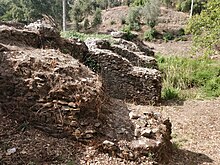The Roman Dam of Pego da Moura is a small buttress dam situated in the municipality of Grândola in the Setúbal District of Portugal.
Barragem Romana do Pego da Moura | |
 Photo of the dam with the buttresses clearly visible | |
| Location | Grândola, Setúbal District, Portugal |
|---|---|
| Coordinates | 38°09′18″N 8°34′42″W / 38.1550°N 8.5783°W |
| Type | Ruins from the Roman Empire |
| Site notes | |
| Discovered | 18th century |
| Excavation dates | 1990; 1997 |
| Condition | Fair |
| Public access | Yes |
Description
editThe dam was constructed during the middle of the Roman occupation of Portugal. Built in two phases, it consists of a rectilinear wall that was originally about 40 metres long. The ruins have a maximum height of 3 m. and a thickness of 2.90 m. There are six downstream buttresses that are 2.50 m. apart, which are around 2.70 m. thick and 2.90 m long. There is also a semi-circular well, built in masonry, which probably comes from a later period. The dam was almost entirely constructed using opus incertum. In the middle there is a vaulted chamber for which opus signinum was used. Traces of a water mill can be identified.[1][2][3]
The dam is located on a small stream and has an approximate watershed of just 2.3 km2. The area of water that could be dammed was around 0.12 km2. The small size means that researchers have concluded that the dam served agricultural purposes, despite evidence of aqueducts in the area.[4]
Archaeological investigations
editThe dam was first noted by Father Carvalho Costa in 1712 in his work, Corographia Portugueza. However, it was not until the 1990s that a brief archaeological study was conducted. Formal classification was concluded in 1996, after which a more detailed archaeological study was started.[3][4]
See also
editReferences
edit- ^ "Barragem Romana do Pego da Moura". Grândola Município. Retrieved 3 October 2020.
- ^ Martins, A. "Barragem romana do Pego da Moura". Patrimonio Cultural. Retrieved 3 October 2020.
- ^ a b "Barragem Romana do Pego da Moura". SIPA: Sistema de Informação para o Património Arquitetónico. Retrieved 3 October 2020.
- ^ a b De Mascarenhas, José Manuel; Cardoso, Joao; Alvares, Teresa. "Património cultural dos cursos de água da bacia do Sado". ResearchGate. Retrieved 3 October 2020.